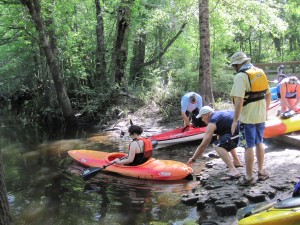Participating in water activities always carries an element of danger, some seen and unseen. It’s important to be aware of one’s surroundings and be prepared for emergencies in the event one should arise. Even the most experienced paddlers can sometimes find themselves in unexpected situations. Proper planning and good techniques can save lives.
Safety Equipment for Kayaks and Canoes
Floatation is paramount to survival. Always carry a life jacket or life vest when paddling and more importantly, wear it. Statistics released by the U.S. Coast Guard for 2009 listed drowning percentages involving canoes at 92% and kayaks at 87%. The most common accident among both types of vessels was capsizing. These statistics illustrate why it is so important to wear a life vest.
In addition to life vests, floatation bags for kayaks that don’t have built in air compartments are worth the extra money. In the event of a capsize these life saving floatation devices can keep a kayak afloat and allow the paddler time to perform a self-rescue, another valuable technique that every paddler should learn. Overturned canoes will also float but may require more effort to recover.
Other equipment essential for paddlers to have is a whistle or air horn (whistles are easily attached to a life vest,) bailing or bilge device for quickly emptying a swamped canoe or kayak and a spare paddle in case the primary one is damaged or lost. A paddle leash can help keep a paddle from being swept away in a strong current, but they should not be solely relied on or used in breaking surf conditions.
Practice Paddling and Self-Rescue Techniques
Part of canoeing or kayaking is knowing personal limitations. This is why knowing proper paddling techniques like bracing or turning into a wave is so important. Canoes and kayaks can get swamped or capsized by unobservant motor boats, surf or bad weather. Knowing what to do in these situations is crucial.
Equally important is knowing how to perform a self-rescue. While it is advisable to always paddle with a friend or group of friends, bear in mind that they may lack the necessary skills to assist in a rescue or they may be involved in a crisis of their own when help is needed. Practice self-rescue in shallow water with the aid of a friend or find out when the local paddling club will be holding a kayak clinic.
Although a capsize scenario usually comes on suddenly, always try to maintain a grip on the paddle. Not only is it needed to direct the boat back to shore, but with the aid of a paddle float it can aid in re-entry into a kayak.
Tips for Planning a Float Trip
Research the area to be paddled, review local weather reports and find out what the local water levels or tides will be. Be aware of the dangers of hypothermia and dress for immersion. While it might be warm outside, water temperatures can vary drastically and hypothermia can set in quickly.
Always leave a float plan with a friend or loved one so that someone will know where to start looking if the group fails to return. Paddle with a friend or a group and make sure that cell phones are stored in a dry bag and safely secured inside of the boat. For extra security, consider investing in a personal emergency locator beacon as cell phones may not always be functional or in range of a signal
Kayaking and canoeing can be a fun and safe activity with the proper precautions. Paddle safe and have fun doing it.
This article is copyrighted by Beverly Hill

